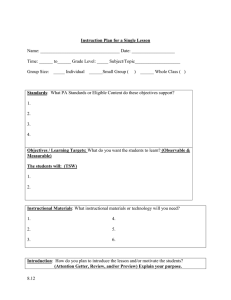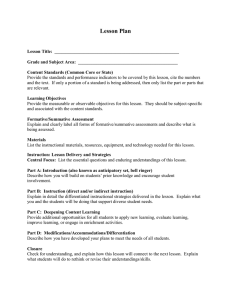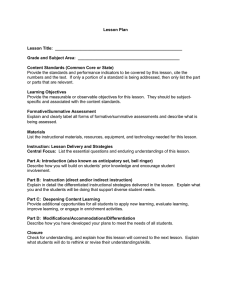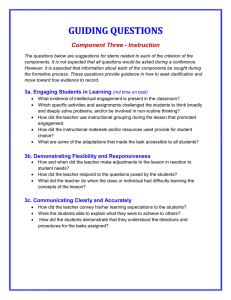738_Applied American Government 2008-09
advertisement
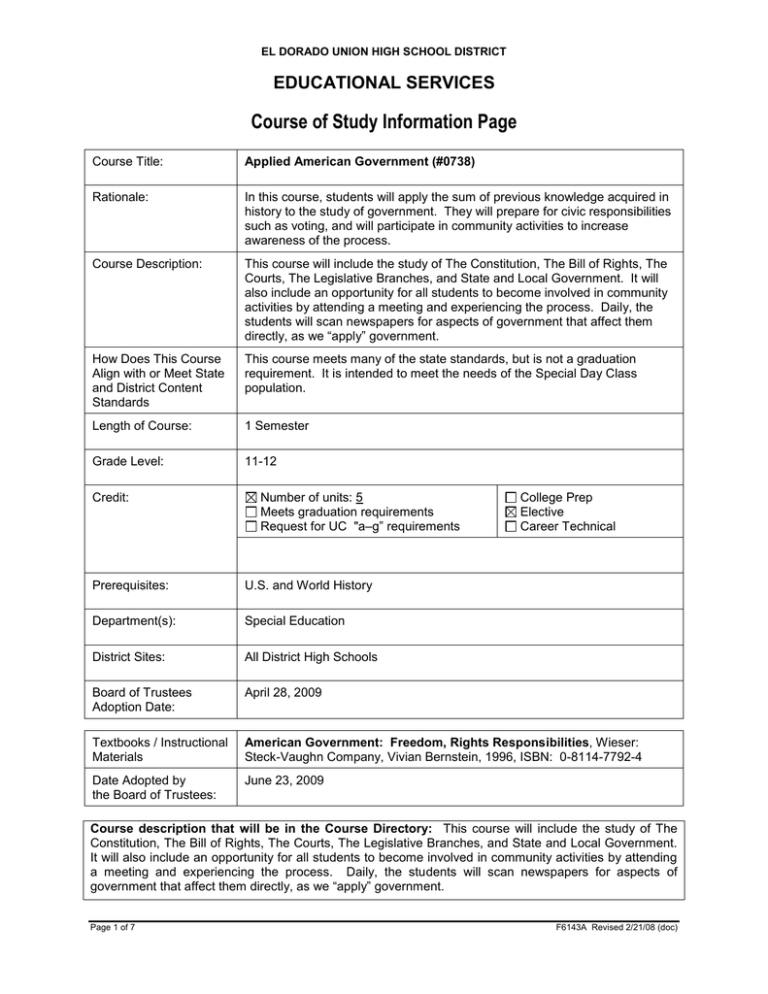
EL DORADO UNION HIGH SCHOOL DISTRICT EDUCATIONAL SERVICES Course of Study Information Page Course Title: Applied American Government (#0738) Rationale: In this course, students will apply the sum of previous knowledge acquired in history to the study of government. They will prepare for civic responsibilities such as voting, and will participate in community activities to increase awareness of the process. Course Description: This course will include the study of The Constitution, The Bill of Rights, The Courts, The Legislative Branches, and State and Local Government. It will also include an opportunity for all students to become involved in community activities by attending a meeting and experiencing the process. Daily, the students will scan newspapers for aspects of government that affect them directly, as we “apply” government. How Does This Course Align with or Meet State and District Content Standards This course meets many of the state standards, but is not a graduation requirement. It is intended to meet the needs of the Special Day Class population. Length of Course: 1 Semester Grade Level: 11-12 Credit: Number of units: 5 Meets graduation requirements Request for UC "a–g” requirements College Prep Elective Career Technical Prerequisites: U.S. and World History Department(s): Special Education District Sites: All District High Schools Board of Trustees Adoption Date: April 28, 2009 Textbooks / Instructional Materials American Government: Freedom, Rights Responsibilities, Wieser: Steck-Vaughn Company, Vivian Bernstein, 1996, ISBN: 0-8114-7792-4 Date Adopted by the Board of Trustees: June 23, 2009 Course description that will be in the Course Directory: This course will include the study of The Constitution, The Bill of Rights, The Courts, The Legislative Branches, and State and Local Government. It will also include an opportunity for all students to become involved in community activities by attending a meeting and experiencing the process. Daily, the students will scan newspapers for aspects of government that affect them directly, as we “apply” government. Page 1 of 7 F6143A Revised 2/21/08 (doc) EL DORADO UNION HIGH SCHOOL DISTRICT EDUCATIONAL SERVICES Course Title: Applied American Government (#0738) TABLE OF CONTENTS STATE CONTENT STANDARD # CONTENT STANDARD/UNIT TOPIC PAGE 1 / 12.3 Forms of Government 3 2 / 12.1 U.S. Constitution of Bill of Rights 4 3 / 12.7, 12.8 Political Process/State, Federal and Local Government 5 4 / 12.4 Branches of Government 6 Page 2 of 7 F6143A Revised 2/21/08 (doc) EL DORADO UNION HIGH SCHOOL DISTRICT EDUCATIONAL SERVICES Department: Special Education Course Title: Applied American Government (#0738) UNIT/STANDARD #: 1 / 12.3 LEARNING OUTCOME: Students will list and compare the different forms of government LEARNING OUTCOME 1. What students will learn, know, and be able to do? (Must be aligned to state content standards.) Students will compare different forms of government and their advantages and disadvantages. INSTRUCTIONAL STRATEGIES 2. Instructional strategies that will be used to engage students. Students will engage in interactive video presentations on the different forms of government, will create posters and make presentations. A chart will be maintained by every student in preparation for standards testing, and as a visual. ASSESSMENTS 3. How will we know that students have learned? Include both Formative (for learning) and Summative (of learning) assessment examples. Students will complete ongoing weekly oral assessments in this class. Formative assessment will be happening at all times. The summative assessment will be standards based, and will include a direct example of the exact same governmental chart the students have been using in class for this unit. Since they have been using it to learn, the hope would be that they can demonstrate they have met the standard by filling in the chart. INTERVENTIONS 4. What will we do if students do not learn? (Outline the planned intervention strategies) Students who need more reinforcement, we will re-teach the material with flashcards, one-on-one time, and offer oral testing. If it is the whole class, we will reteach the unit. 5. What will we do if students already know it? We will assess the learning and move ahead, though this is unlikely in special education. Content Area Standards (Please identify the source) The students will demonstrate mastery of the following content standards: History and Social Science Standards: 12.3 Page 3 of 7 F6143A Revised 2/21/08 (doc) EL DORADO UNION HIGH SCHOOL DISTRICT EDUCATIONAL SERVICES Department: Special Education Course Title: Applied American Government (#0738) UNIT/STANDARD #: 2 / 12.1 LEARNING OUTCOME: Students explain the ideas expressed in the U.S. Constitution and the Bill of Rights LEARNING OUTCOME 1. What students will learn, know, and be able to do? (Must be aligned to state content standards.) Students will understand the Constitution, know the Bill of Rights and understand the importance of both. INSTRUCTIONAL STRATEGIES 2. Instructional strategies that will be used to engage students. Students will read cases involving young people and determine how The Bill of Rights applies, will read the newspapers and determine if Constitutional law applies, will create posters and present to the class. All students will be creating an ongoing notebook chart as we learn. ASSESSMENTS 3. How will we know that students have learned? Include both Formative (for learning) and Summative (of learning) assessment examples. Students will demonstrate learning formatively by responding in class and participation. Summatively, the students will be required to fill in a chart on the Constitution and Bill of Rights. INTERVENTIONS 4. What will we do if students do not learn? (Outline the planned intervention strategies) Students who aren’t learning will be noticed in the formative process, and will be given reinforcement lessons, flashcards, and lower level reading materials to reinforce the curriculum. Alternate assessment is an option. 5. What will we do if students already know it? N/A Content Area Standards (Please identify the source) The students will demonstrate mastery of the following content standards: History and Social Science Standards: 12.1 Students explain the fundamental principles and moral values of American democracy as express in the U.S. Constitution. Chronological and Spatial Thinking Page 4 of 7 F6143A Revised 2/21/08 (doc) EL DORADO UNION HIGH SCHOOL DISTRICT EDUCATIONAL SERVICES Department: Special Education Course Title: Applied American Government (#0738) UNIT/STANDARD #: 3 / 12.7, 12.8 LEARNING OUTCOME: Students will explain the role citizens can make in the political process, and will compare the difference between state, federal and local powers LEARNING OUTCOME 1. What students will learn, know, and be able to do? (Must be aligned to state content standards.) Students will understand the power of Democracy, citizen participation, state and local powers and will know how to register to vote, go to a local community meetings, and actively participate in the process. INSTRUCTIONAL STRATEGIES 2. Instructional strategies that will be used to engage students. Students will be required to collect media articles that are influential to analyze, will read editorials, will fill out voter registration forms for practice, will attend a community meeting, will read local issues and debate, and will read their textbook. ASSESSMENTS 3. How will we know that students have learned? Include both Formative (for learning) and Summative (of learning) assessment examples. Students will demonstrate formative learning on an ongoing basis as they interact with the materials in class, turning in papers, presenting well in class, answering questions, bringing in appropriate newspaper articles, and responding well when asked for prior knowledge. Summatively, students will be given a written test. INTERVENTIONS 4. What will we do if students do not learn? (Outline the planned intervention strategies) Students who aren’t learning will be noticed in the formative process, and will be given reinforcement lessons, flashcards, and lower level reading materials to reinforce the curriculum. Alternate assessment is an option. 5. What will we do if students already know it? N/A Content Area Standards (Please identify the source) Page 5 of 7 F6143A Revised 2/21/08 (doc) The students will demonstrate mastery of the following content standards: History and Social Science Standards: 12.7 Students analyze and compare the powers and procedures of the national, state, tribal, and local governments. 12.8 Students evaluate, take and defend positions on the influence of the media on American political life. EL DORADO UNION HIGH SCHOOL DISTRICT EDUCATIONAL SERVICES Department: Special Education Course Title: Applied American Government (#0738) UNIT/STANDARD #: 4 / 12.4 LEARNING OUTCOME: Students will compare the three branches of the government, and apply the Bill of Rights to current legislative proposals LEARNING OUTCOME 1. What students will learn, know, and be able to do? (Must be aligned to state content standards.) Will know the Executive Branch and the role of the President, the Legislative Branch, and how to introduce a bill to the Senate. Will understand the concept of a system of checks and balance, and why that is an important concept. Will be able to describe the court system in the United States, and how the Bill of Rights is connected to the system of courts and our protections under the law. INSTRUCTIONAL STRATEGIES 2. Instructional strategies that will be used to engage students. Students will analyze charts of the 3 branches of government, and then create their own. Students will study modified documentation of court cases, then study how the law was applied. Students will hold a mock trail. Students will have the opportunity to visit the court in session and write a response to a format. Students will select a bill on the Internet that is currently proposed, and then decide whether they are for or against it. They will write to their congressman. ASSESSMENTS 3. How will we know that students have learned? Include both Formative (for learning) and Summative (of learning) assessment examples. Formative assessment is daily, as students are required to participate orally and in written response in class. If students are unable to participate, then we need to slow down and re-teach. Summatively, there will be a test on each of the three branches individually in this unit. Then, there will be a test on the whole unit, which will be just 10 questions. INTERVENTIONS 4. What will we do if students do not learn? (Outline the planned intervention strategies) This will be discovered in the formative stage, and we will slow down and spend more time in this unit. We will re-teach, do daily oral language, make giant flashcards and post around the room, send home homework, and find supplemental materials. 5. What will we do if students already know it? N/A Content Area Standards (Please identify the source) Page 6 of 7 F6143A Revised 2/21/08 (doc) The students will demonstrate mastery of the following content standards: History and Social Science Standards: 12.4 The unique roles and responsibilities of the three branches of government as established by the U.S. Constitution. Page 7 of 7 F6143A Revised 2/21/08 (doc)
